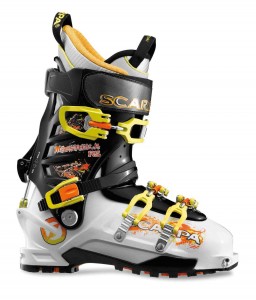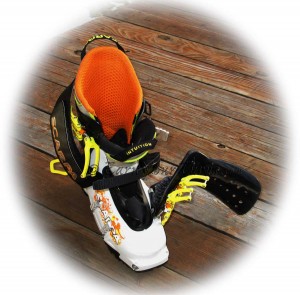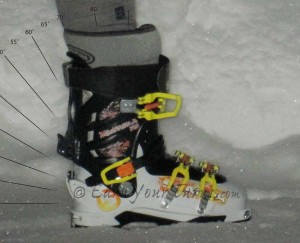The Chams were amazingly responsive, and the only fiddling I had to do with the Yak was attaching the safety strap. It is true that to really enjoy making powerful alpine turns you need a good system. This was a sweet one, with a solid transmission of power mounted to a pair of planks that had zero problem holding an edge, whether in the steep runway of a rock lined couloir or banking giant slalom sized turns down an open bowl, the Chams held and Scarpa’s Maestrale was the maestro, conducting every command with power and precision.
Downhill Power
And yet, the Maestrale only tips the scales at 3 lbs. 6 ounces (1.34 kg) per boot. Scarpa achieves the mix of downhill control in a welterweight frame by using Grilamid for the lower shell, and a very stiff cuff and tongue. Some might even say too stiff, and I originally agreed because when I flipped the walk mode switch to downhill I latched into the first position, yielding a mere 16° forward lean. The cuff is so stiff that it is hard to get it to flex much, and from a relatively upright position it was hard to drive the boot. However, when I bent forward before flipping the mode switch it latched into the 2nd position, yielding a forward lean of 20°, perfect for initiating and giving enough leverage that I could drive my knees forward to hold a carve.
There is another aspect of the too stiff cuff that requires a bit of technique to overcome, but not much. That is when simply getting in and out of the boot. Fortunately Scarpa accounted for that with their Axial tongue closure that hinges the tongue to the side, not forward. Because of how stiff the cuff is, it takes a bit of force to open past the cuff. However, once open it is super easy to get your foot in and out of the boot. If you don’t open the tongue, it’s dang difficult.
Fit
Maestrale comes with a tongued Intuition Pro Flex liner that is pre-lasted. For many it may comfortable out of the box, but don’t hestitate to heat it on a stack heater for at least 5 minutes before wearing them long term, especially if the shell is the right size but it doesn’t feel comfortable. If sized right, it will once molded. I’m not a fan of tongued liners since my low-instep demands filler material that is absent with all tongued liners. So I swapped in an overlap style Intuition liner.
Four buckles and a power strap hold your foot securely inside. The plastic toothed Predator instep strap holds your heel securely in the pocket. It is shaped to hold on the upper side of the tongue bellows so it increases pressure around the base of your lower leg, adding extra resistance to flexing forward – perhaps too much. If I forced the instep strap to hold on the lower part of the tongue bellows the boot flexed more progressively, with it on the upper notch I felt like I hit a wall. Bigger guys will probably appreciate this, I did not.
Another pleasant surprise with the Maestrale RS was the use of Dynafit brand tech fittings with the alignment bumper on the toes. It is a subtle thing but it does make lining up your boot with the toe pins of a tech binding noticeably easier.
Touring Performance
As you would expect the bottom of the boot is adorned with a lugged Vibram sole for superior grip on rock, talus, or asphalt and a rockered toe makes that much more comfortable and natural.
Conclusion
The Maestrale certainly doesn’t claim to deliver race-caliber downhill performance, but it delivers more than enough for recreational charging, or skiing challenging terrain deep in the backcountry where limits won’t be from your boots – your biggest challenge will be mental fortitude, not whether the Maestrale’s can deliver enough power. That and they walk like a dream, making deep and long days more enjoyable, and thus more common.
If you’re not quite ready to pony up for the Maestrale RS, the economical Maestrale features slightly softer downhill flex with a bit more weight using a heavier Pebax Renew shell and cuff. Plus there are women’s versions, known as the Gea and Gea RS.
Scarpa
Maestrale RS
MSRP: $700
Weight/boot (mondo 27): 3 lbs. 6 oz. (1.34 kg)
Sizes available: 24.5 – 32
Gea RS
MSRP: $700
Sizes available: 22.5 – 27
© 2013




3 comments
2 pings
Hi Dostie, I’d be interested to hear more on the Cham 97 High Mtn ski and also any thoughts on how it compares to the Blizzard Kabookie ski. I’m over in the UK and travel by plane to ski (mainly in Europe), so am looking for a bit of a do it all ski for touring and in the ski area. Mainly short tours.
cheers
Pretty much summed up my experience so far. They rip on firm snow. Soon as I get some more time in with deep snow and crud I’ll file a longer report. I can assure you they break trail (w/a free pivot) beautifully. 😉
Wow! That’s light. I just put my Scarpa Rush AT boots on the postal scale. 3 lbs 8.7 ounces each. That’s for a size 28.5, no custom footbed yet.
The Rush is basically a Maestrale with a lighter cuff; a three buckle boot.
[…] when I found that I simply could not jam my feet into my Lange XT‘s, I opted for the Scarpa Maestrale‘s with a tongue that hinges open and completely out of the way. The solution for getting in […]
[…] the meantime it can’t hurt to petition Scarpa to incorporate the walk mode mechanics of their Maestrale in their telemark boot […]